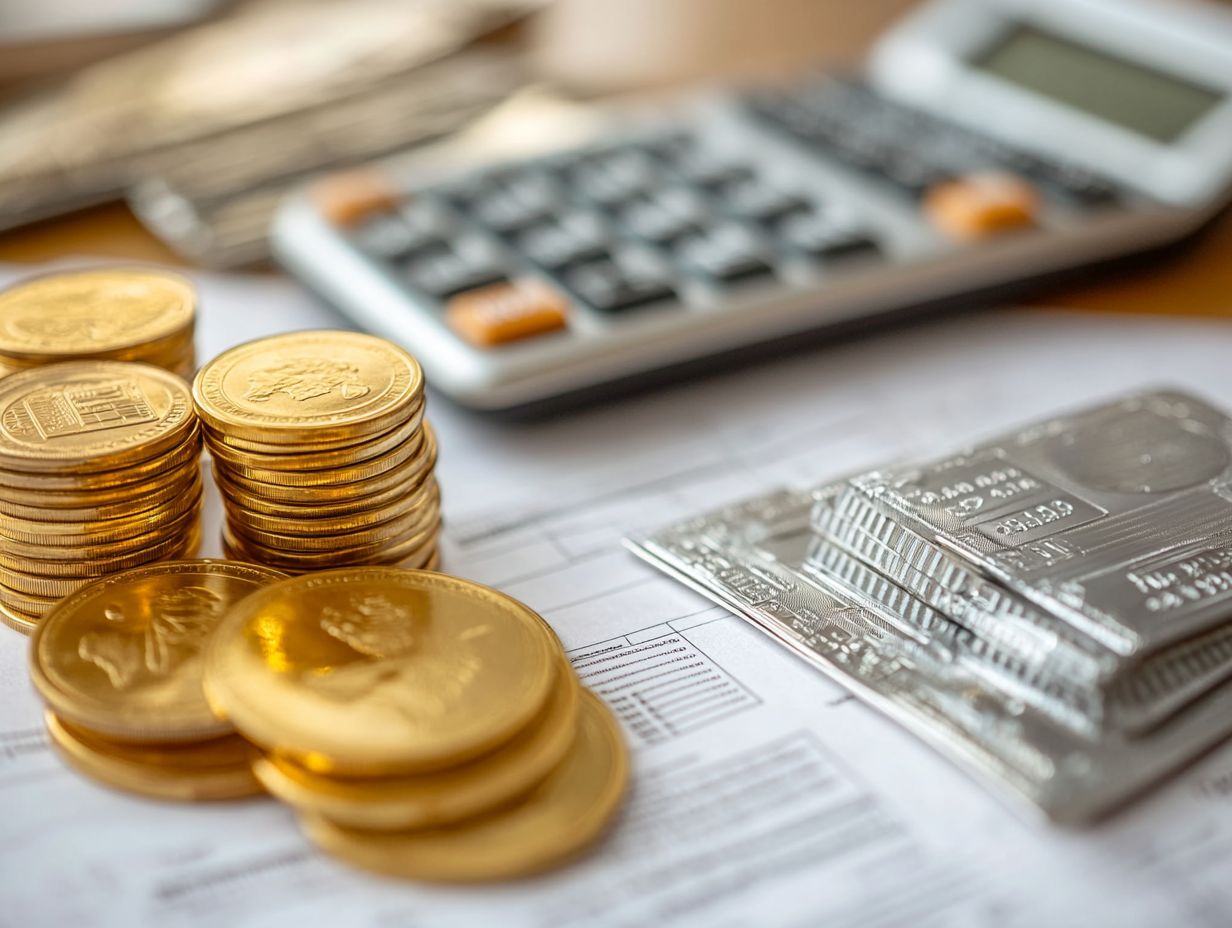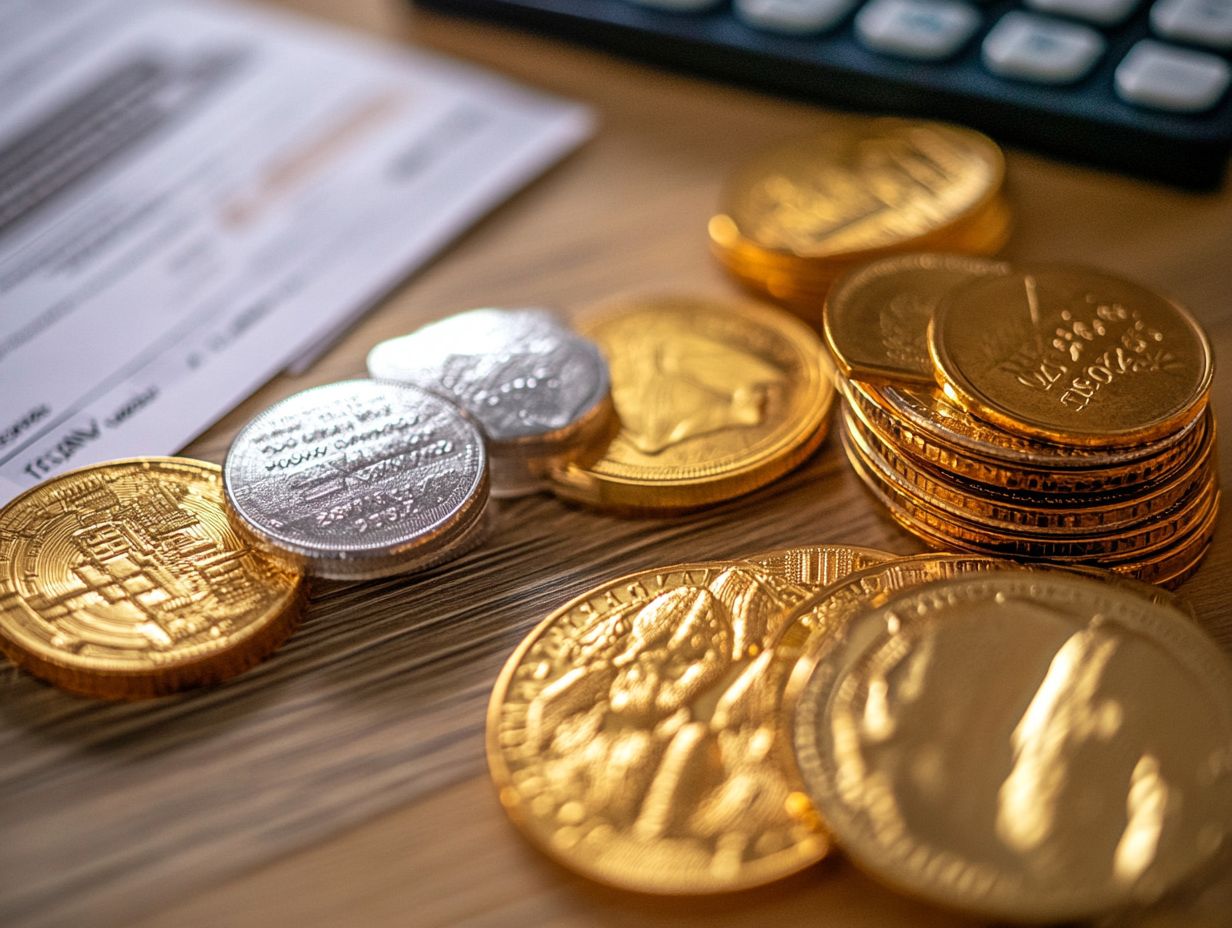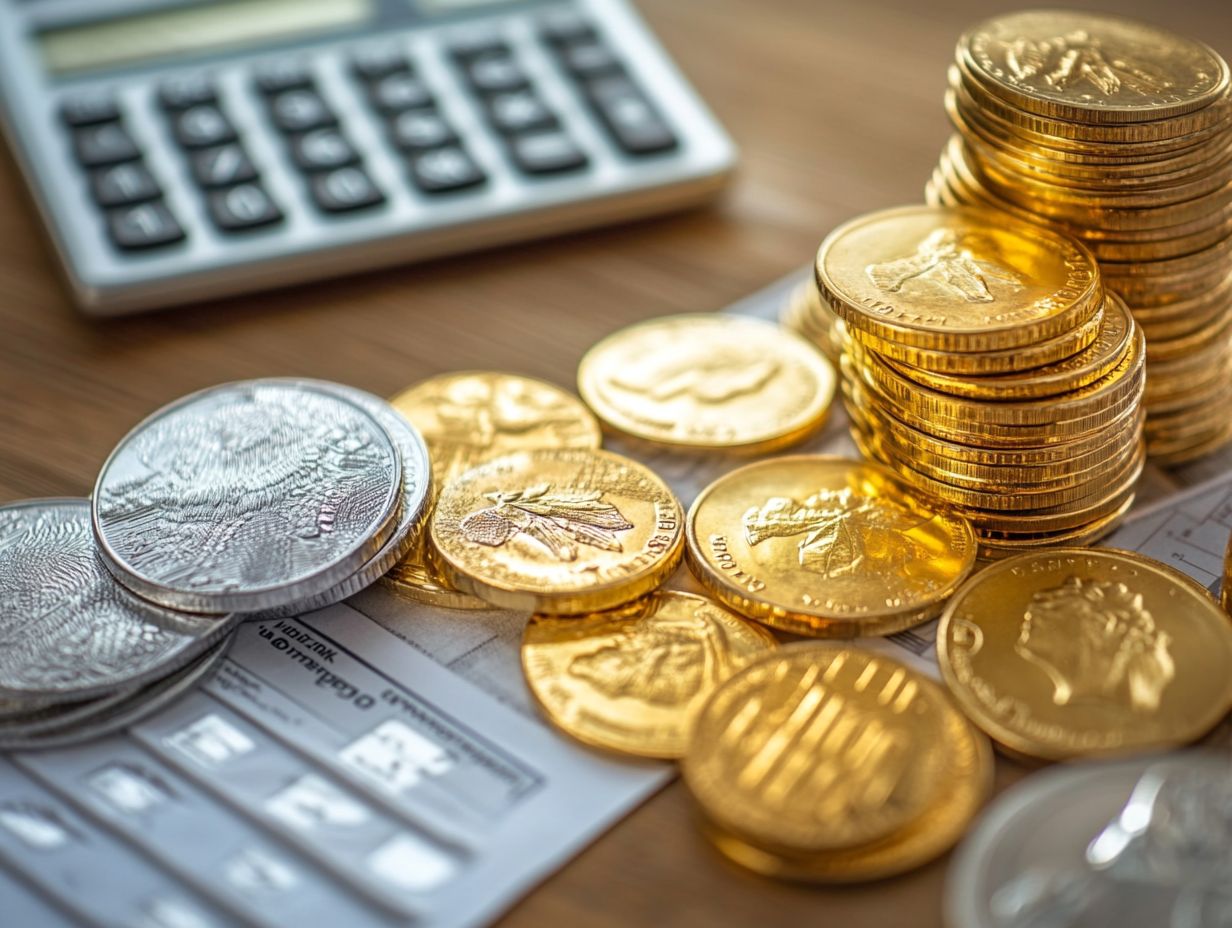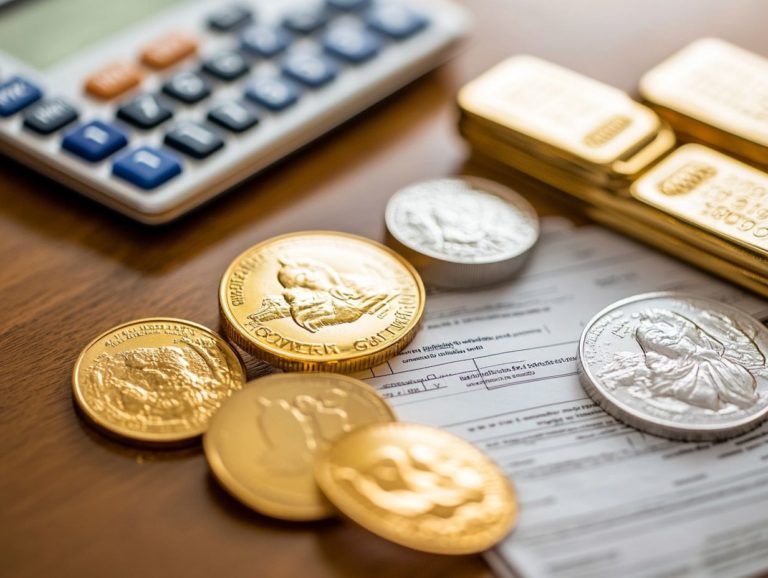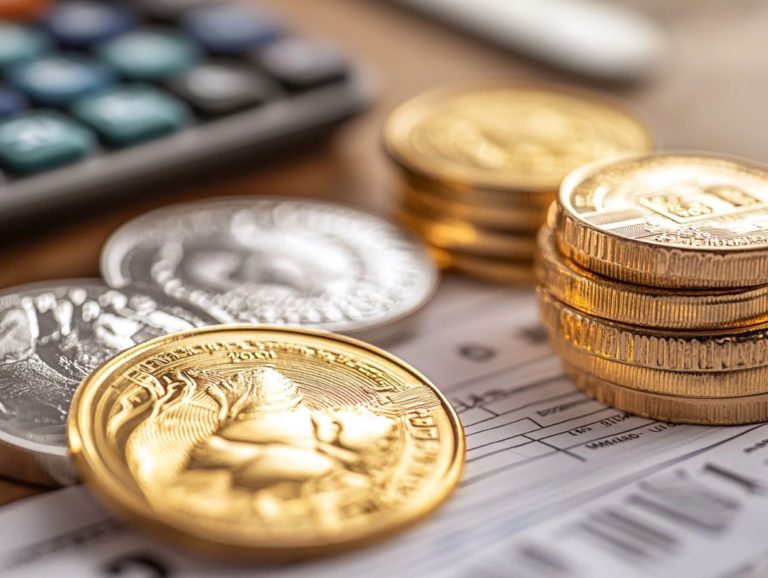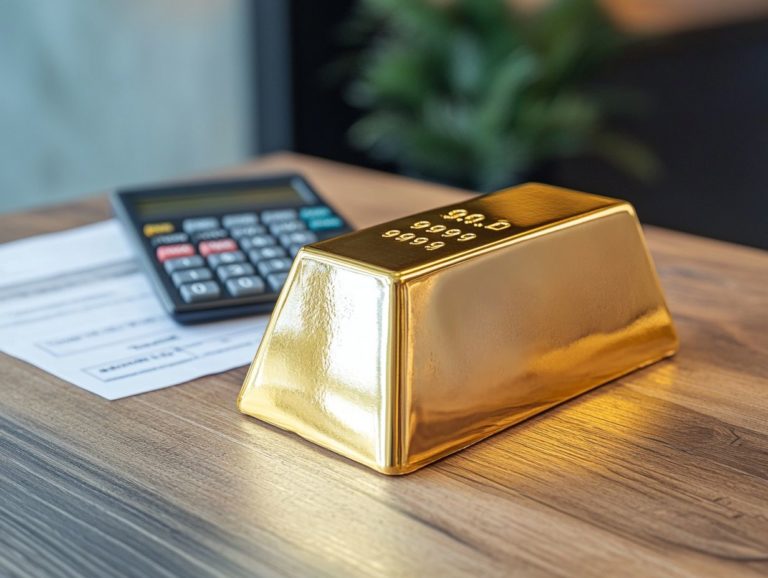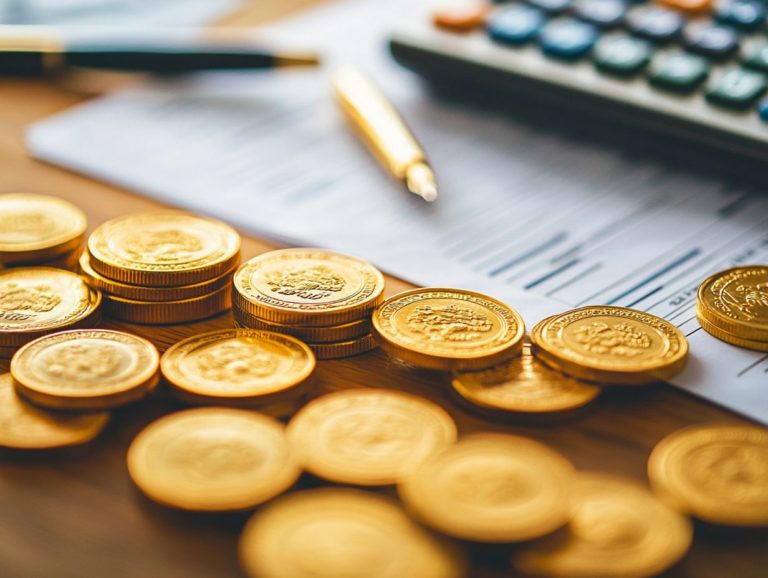Tax Consequences of Owning Precious Metals as a Business
Ready to dive into the exciting world of precious metals? Owning these valuable assets can be a lucrative venture, but it also comes with unique tax implications that you need to understand fully.
Navigating the financial landscape means grasping everything from capital gains tax to self-employment tax. This article explores the benefits of diversifying your assets with precious metals while highlighting the risks associated with market volatility and security concerns.
You will receive guidance on accurately reporting your precious metal holdings on tax returns, ensuring you are well-prepared at every step of the journey.
Contents
- Key Takeaways:
- Tax Implications of Owning Precious Metals
- Benefits of Owning Precious Metals as a Business
- Risks of Owning Precious Metals as a Business
- How to Properly Report Precious Metals on Tax Returns
- Frequently Asked Questions
- What are the tax consequences of owning precious metals as a business?
- Do I have to pay taxes on precious metals I use for business operations?
- Is there a difference in tax treatment for different types of precious metals?
- Are there any tax deductions available for owning precious metals as a business?
- How are taxes calculated for precious metals that appreciate in value?
- Are there any special tax considerations for precious metals used for jewelry making?
Key Takeaways:
- Businesses that own precious metals may be subject to capital gains tax, self-employment tax, and other tax considerations.
- Owning precious metals can provide benefits such as asset diversification and protection against inflation.
- However, there are risks, including market volatility and the need for proper storage and security measures.
- It is important for businesses to report their precious metal holdings on tax returns and keep accurate documentation.
What are Precious Metals?
Precious metals, such as gold, silver, and platinum, are valuable commodities known for their rarity and unique properties. They have a rich history as stores of wealth. During times of economic uncertainty, these metals act as a strong hedge against inflation and currency fluctuations, making them appealing investment options for individual and institutional investors.
These metals not only have visual allure but also serve as reliable symbols of wealth and stability. Gold bullion has long been synonymous with affluence, while silver bullion offers a more accessible entry point for new investors. Current market trends indicate a growing interest in gold and silver, particularly amid rising geopolitical tensions and the potential for economic downturns.
In various investment strategies, precious metals are key diversification tools, especially during market instability, enhancing both liquidity and the resilience of your investment portfolio.
Tax Implications of Owning Precious Metals
Understanding the tax implications of owning precious metals is essential for optimizing your financial strategies and effectively managing your tax liability.
The classification of these assets—whether as collectibles or capital assets—determines different tax rates and reporting requirements that can significantly impact your potential capital gains and losses. The IRS has specific guidelines governing the taxation of precious metals, which should inform your investment decisions.
Being informed enables you to navigate this complex landscape with confidence.
Capital Gains Tax
As an investor in precious metals, understanding capital gains tax is crucial. This tax affects your profit when you sell these assets. It can vary significantly depending on how long you’ve held the asset; long-term gains usually enjoy lower tax rates, while short-term gains are taxed as ordinary income.
Staying informed about IRS rulings is essential, as they can add layers of complexity to your tax obligations. Holding precious metals for more than a year can lead to more favorable tax conditions, encouraging longer-term investment strategies.
You may also want to explore tactics to minimize your tax liability, such as offsetting gains with losses from other investments. These strategies not only aid in planning but also help maximize your returns while navigating the intricate landscape of capital gains tax.
Self-Employment Tax
Self-employment tax presents a distinctive challenge for you if you’re investing in precious metals, especially if you’re trading them as part of a business venture rather than just for personal gain. This additional tax on income from self-employment activities can notably impact your overall tax liability.
Understanding the IRS guidelines regarding what qualifies as self-employment income is essential for you to remain compliant and enhance your financial strategies. Navigating this complex landscape necessitates a clear grasp of how the IRS classifies your trading activities and the criteria that determine self-employment income. For example, the frequency and intent behind your trades can significantly influence this classification.
It’s prudent for you to keep careful records of your transactions and think about the structure of your investments—perhaps even considering forming a limited liability company (LLC) or a partnership—to potentially reduce your tax burdens.
Utilizing tax deductions related to business expenses can be crucial in lowering your taxable income, enabling you to retain more of your hard-earned profits while still staying within the bounds of IRS regulations.
Other Tax Considerations
Besides capital gains tax, there are several crucial tax considerations you need to keep in mind when investing in precious metals. Depending on your jurisdiction, purchasing certain precious metals may trigger sales tax. Furthermore, the IRS classifies gold and silver as collectibles, which brings distinct tax implications compared to other capital assets. If you don’t navigate these complexities carefully, you could find yourself facing significant tax compliance issues later on.
Since collectibles often incur a higher maximum capital gains rate than standard investments, it’s vital for you to evaluate how these classifications influence your overall investment strategy. Adherence to IRS regulations is non-negotiable, as there are specific reporting requirements for transactions involving precious metals. Grasping the nuances between collectible metals—like bullion versus numismatics—is essential for crafting a well-informed investment approach.
Therefore, it’s advisable to seek expert guidance on the tax implications related to your investments. This proactive step can help you steer clear of potential pitfalls that might undermine your financial returns.
Benefits of Owning Precious Metals as a Business
Owning precious metals as part of your business can present a wealth of benefits that elevate your investment portfolio and financial strategy. One significant advantage is the diversification of your assets, which serves to mitigate the risks typically associated with traditional investments such as stocks and bonds.
Precious metals can serve as a strong hedge against inflation during times of economic uncertainty. By integrating these valuable assets into your business framework, you can unlock unique investment strategies that align seamlessly with your long-term financial objectives.
Diversification of Assets
Diversifying your assets by incorporating precious metals can significantly bolster your investment portfolio’s resilience and potential for financial growth. By distributing your investments across various asset classes—such as gold, silver, and platinum—you can effectively reduce your exposure to market volatility and economic downturns.
This strategic approach not only mitigates risk but also maximizes potential returns, establishing precious metals as a crucial element of a comprehensive investment strategy.
- Gold: A renowned safe haven during turbulent economic times, often appreciating when traditional stock markets stumble.
- Silver: Boasts unique industrial demand, presenting an alternative growth avenue that can offset fluctuations in other markets.
- Platinum: Its value can be influenced by factors distinct from those affecting gold or silver, such as supply constraints.
By weaving these precious metals into your investment portfolio, you can pave the way for a more stable growth trajectory, ultimately enriching your financial planning and security.
Don’t miss out on unique investment strategies! Start exploring how precious metals can benefit your financial strategy today!
Inflation Hedge
Precious metals serve as a reliable hedge against inflation. They provide a protective barrier against declining purchasing power during economic uncertainty. Historically, assets like gold and silver have preserved their value in inflationary periods. This makes them appealing choices for investors keen on safeguarding their wealth.
By understanding how to integrate precious metals into your investment strategies, you can enhance your ability to navigate turbulent financial landscapes.
Take the 1970s as an example—a decade characterized by soaring inflation due to oil crises, during which gold prices surged. This illustrates how these metals can retain their value when traditional currencies struggle. Today, more investors are gravitating toward precious metals, especially during geopolitical instability or economic downturns.
Diversifying your portfolio with these tangible assets not only hedges against inflation but also positions you to benefit from price appreciation. A well-planned allocation allows for both safety and growth, ensuring your investments remain resilient amidst rising costs and market volatility.
Risks of Owning Precious Metals as a Business
Owning precious metals offers many benefits. However, it comes with risks that you, as an aspiring business investor, should recognize. Market volatility can significantly affect the value of these assets, leading to uncertainty about future returns.
Storage and security issues can complicate your management of precious metals. It’s essential to engage in thoughtful planning as you navigate this investment landscape.
Market Volatility
Market volatility poses a significant risk for you as an investor in precious metals. Fluctuating prices can lead to unpredictable returns and potential capital losses. Factors like global economic events, currency fluctuations, and shifts in investor sentiment can influence these changes.
Navigating this volatility is crucial if you aim to include precious metals in your investment strategy. Geopolitical tensions, trade wars, and even natural disasters can trigger sharp price swings in this market. Staying informed is essential; during economic uncertainty, precious metals often become a safe haven.
To manage these risks, consider diversifying your portfolio and employing strategies like hedging, which minimize potential losses in investments. Stay updated on global news and use analytical tools to anticipate potential shifts. This way, you’ll be better equipped to make informed decisions and reduce possible losses.
Storage and Security Concerns
Storage and security are critical for you as an investor in precious metals. These tangible assets require careful handling and protection from theft or damage. Whether you’re holding bullion, coins, or bars, the right storage solutions are essential to maintain the integrity of your investment.
Ignoring these concerns could lead to significant financial losses and undermine the overall value of your portfolio. Explore various secure storage options, such as professional vault services that offer top-notch security and insurance or personal safes if you prefer to keep your assets at home. Each method has advantages and drawbacks, so evaluate factors like accessibility, cost, and security features carefully.
Following careful handling protocols—like using gloves when touching coins and avoiding moisture—can reduce the risk of damage. By prioritizing secure storage solutions and adopting proper care techniques, you can safeguard your precious metals. This approach ensures that both their physical condition and long-term value remain intact.
Start investing in precious metals today to secure your financial future!
How to Properly Report Precious Metals on Tax Returns
Properly reporting precious metals on your tax returns is essential for following tax rules. Prioritize this to avoid penalties and ensure an accurate assessment of your tax liability.
The IRS requires specific reporting for transactions involving precious metals. You must use Form 1099-B for sales exceeding a certain threshold. This form collects key info about your proceeds that can affect how much tax you owe.
Understanding these requirements is crucial for keeping accurate records and adhering to tax laws.
Forms and Documentation Required
For reporting precious metals on your tax returns, specific forms and documentation are essential. Notably, you’ll need Form 1099-B for any sales that exceed a certain threshold. This form captures critical information that impacts your tax liability.
In addition to Form 1099-B, you should also keep track of other necessary forms, such as Form 8949. This form details your capital gains and losses. Maintaining thorough records is vital; keep invoices, receipts, and any relevant correspondence for each transaction. By organizing this documentation, you can better track your investment performance and provide solid proof come tax time.
Establishing a dedicated filing system—whether physical or digital—is crucial. Don’t wait until tax time! Ensuring accuracy and completeness in reporting your precious metals will streamline the tax process and protect you from unnecessary penalties.
Frequently Asked Questions
What are the tax consequences of owning precious metals as a business?
The tax consequences of owning precious metals as a business can vary. They depend on the type of metals, the method of acquisition, and the intended use. It’s important to consult with a tax professional to understand the specific tax implications for your business.
Do I have to pay taxes on precious metals I use for business operations?
Yes, any precious metals used for business operations, such as inventory or equipment, are subject to taxation. This applies to both buying and selling the metals.
Is there a difference in tax treatment for different types of precious metals?
Yes, there can be differences in tax treatment for certain types of precious metals. For example, gold is taxed differently than silver or platinum. Again, it is best to consult a tax professional for specific guidance.
Are there any tax deductions available for owning precious metals as a business?
Yes, there may be deductions available for expenses related to owning and operating a business that deals with precious metals. These can include storage fees, insurance, and transportation costs.
How are taxes calculated for precious metals that appreciate in value?
Taxes on precious metals that appreciate in value are based on the capital gains tax rate. This rate can vary depending on how long the metals were held before being sold. Again, it’s important to consult with a tax professional for specific guidance.
Are there any special tax considerations for precious metals used for jewelry making?
Yes, businesses that use precious metals for jewelry making may be eligible for certain tax exemptions or deductions. These can include sales tax exemptions for materials used in production and deductions for costs associated with creating the jewelry.








